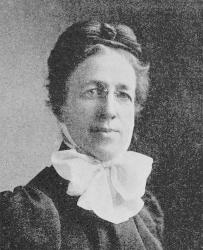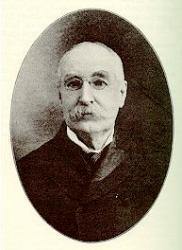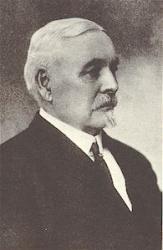Planning worship?
Check out our sister site, ZeteoSearch.org,
for 20+ additional resources related to your search.
- |
User Links
Person Results
‹ Return to hymnal




Export as CSV
Guillaume Franc
1500 - 1570 Person Name: G. Franc Hymnal Number: 226 Composer of "DUNDEE" in Hallowed Hymns, New and Old
Guillaume Franc
Chester G. Allen
1838 - 1878 Hymnal Number: 162 Composer of "[Praise Him! Praise Him! Jesus, our blessed Redeemer]" in Hallowed Hymns, New and Old Chester G. Allen was known as a teacher, composer and musical writer. He taught music in Cleveland, Ohio public schools. He also edited and compiled collections of music for schools and churches, containing many of his own compositions.
Nancy Naber
Chester G. Allen
George A. Minor
1845 - 1904 Hymnal Number: 143 Composer of "[Sowing in the morning, sowing seeds of kindness]" in Hallowed Hymns, New and Old George A. Minor was a native of Richmond, Virginia. He was an active member of the First Baptist church and led the singing in the Sunday school of that church. He composed several Sunday school hymns. He worked for the Hume-Minor Company, a piano and music dealer, and for the Mason-Hamlin Company,a piano manufacturer.
Dianne Shapiro, excerpted from obituary in "Richmond Times-Dispatch," January 31, 1904
George A. Minor
Harriet Auber
1773 - 1862 Hymnal Number: 220 Author of "Our Blest Redeemer" in Hallowed Hymns, New and Old Auber, Harriet, daughter of Mr. James Auber, b. in London, Oct. 4, 1773. During the greater part of her quiet and secluded life she resided at Broxbourne and Hoddesdon, Herts, and died at the latter place on the 20th Jan., 1862. Miss Auber wrote devotional and other poetry, but only a portion of the former was published in her Spirit of the Psalms, in 1829. This collection is mainly her work, and from it some useful versions of the Psalms have been taken and included in modern hymn-books, about 20 appearing in Spurgeon's Our Own Hymn Book, 1866. Miss Auber's name is widely known, but it is principally through her exquisite lyric, "Our blest Redeemer, ere He breathed," and the Epiphany hymn, "Bright was the guiding star that led." (For criticism of her work, see English Psalters, §. 17.)
In addition to these and other hymns by Miss Auber, which are annotated under their respective first lines, the following are also in C. V., but principally in America:—
1. Arise, ye people, and adore. Easter.
2. As Thy chosen people, Lord. Ps. lxciii.
3. Can guilty man indeed believe? Ps. xciv.
4. Delightful is the task to sing. Ps. cxlvii.
5. Father of Spirits, Nature's God. Ps. cxxxi.
6. Hail, gracious Source of every good. Ps. Ixv.
7. Hasten, Lord, the glorious time. Ps. lxxii.
8. Jehovah reigns, O earth, rejoice. Ps. xccii.
9. Join, all ye servants of the Lord. H. Scriptures.
10. Jesus, Lord, to Thee we sing. Ps. cx.
11. O all ye lands, rejoice in God. Ps. lxvi.
12. O God our Strength, to Thee the song. Ps. lIxxxi.
13. O praise our great and gracious Lord. Ps. lxxviii.
14. On thy church, O power divine. Ps. lxvii.
15. Sweet is the work, O Lord. Sunday.
16. That Thou, O Lord, art ever nigh. Ps. lxxv.
17. The Lord, Who hath redeemed our souls. Ps. xxxi.
18. When all bespeaks a Father's love. Ps. set.
19. When dangers press and fears invade. Ps. lxii.
20. Who, O Lord, when life is o'er. Ps. xv.
21. Whom have we Lord, in heaven, but Thee. Ps. lxxiii.
22. Wide, ye heavenly gates, unfold. Ascension.
23. With hearts in love abounding. Ps. xlv.
24. With joy we hail the sacred day. Sunday.
25. Vainly through the night the ranger. Ps. cxvii.
All these psalm-versions and hymns are from her Spirit of the Psalms, London, 1829.
- John Julian, Dictionary of Hymnology (1907)
=========================
Auber, Harriet, p. 90, ii. The following versions of psalms from her Spirit of the Psalms, 1829, are also in common use:-
1. Great God, wert Thou extreme to mark. Ps. cxxx. "Thy servants in the temple watched," begins with stanza ii. of this.
2. How blest are they who daily prove. Ps. xli.
3. How blest the children of the Lord. Altered from Ps. cxii.
4. Jehovah, great and awful name. Part of Ps. Ixxviii.
5. 0 Thou Whom heaven's bright host revere. Ps. Ixxxiv.
6. Praise the Lord, our mighty King. Ps. cxxxv.
7. Spirit of peace, Who as a [celestial] Dove. Ps. cxxxiii.
8. Thou by Whose strength the mountains stand. Ps. Ixv.
9. To heaven our longing eyes we raise. Ps. cxxi.
10. Vainly through night's weary hours. Ps. cxxvii. Sometimes "Vainly through the night the ranger."
11. While all the golden harps above. Easter.
--John Julian, Dictionary of Hymnology, Appendix, Part II (1907)
See also in:Hymn Writers of the Church
Harriet Auber
John E. Gould

1821 - 1875 Hymnal Number: 237 Composer of "PILOT" in Hallowed Hymns, New and Old John Edgar Gould USA 1821-1875. Born in Bangor, ME, he became a musician. He managed music stores in New York City and Philadelphia, PA., the latter with composer partner, William Fischer. He married Josephine Louisa Barrows, and they had seven children: Blanche, Marie, Ida, John, Josephine, Josephine, and Augusta. He compiled eight religious songbooks from 1846 thru 1869. He died while traveling in Algiers, Africa, and was buried in Philadelphia, PA.
John Perry
John E. Gould
Lizzie Tourjée
1858 - 1913 Person Name: Lizzie S. Tourjee Hymnal Number: 230 Composer of "WELLESLEY" in Hallowed Hymns, New and Old Lizzie Shove Tourjee Estabrook USA 1858-1913. Born in Newport, RI, daughter of a famed music educator, organist, and composer, he encouraged her efforts at composing. When 17, she composed the tune for the famous hymn “Wellesley”. When her father, founder of the New England Conservatory of Music, became editor of the Methodist hymnal, he included her tune in the 1878 edition of the book, naming it for the college she attended, as she had written the tune while attending that school. She married Franklin Estabrook in 1883. They had a son, Rufus. She taught music and was an organist in Auburndale, MA. She died in Newton, MA.
John Perry
Lizzie Tourjée
Lucy Rider Meyer

1849 - 1922 Hymnal Number: 263 Composer of "[The Lord bless thee and keep thee]" in Hallowed Hymns, New and Old Lucy Jane Rider Meyer MD USA 1849-1922. Born at New Haven, VT, she became an author, social worker, teacher, and physician. She attended the New Hampton Literary Institution (a college prep school) and the Upham Theological Seminary. She also went to Oberlin College, graduating in 1872 with her degree in literary studies. In 1873 she entered the Women’s Medical College of PA, but withdrew after two years. She intended to become a Methodist medical missionary, but changed her mind after her then-fiance died in 1875. She did not get her medical degree until 1887, when she obtained it from the Women’s Medical College of Chicago. In 1884 she taught Bible at the Dwight L Moody Young Ladies Seminary, Northfield, MA. In 1885 she met and married a Chicago Methodist pastor and businessman, Rv Josiah Shelley Meyer (1849-1926), also Assistant Secretary for the YMCA in Chicago. He had great business acumen. She called him “Papa”.. he called her “Jennie”. They had a son, Shelly. Lucy became an educator, serving as principal of the Troy Conference Academy in Poultney, VT. After studying chemistry at M.I.T. (1877-78), she became a professor of chemistry for two years at McKendree Coillege in Lebanon, IL (1879-81). She did not wish to continue teaching chemistry. She was a good illustrator and later wrote an introductory book for children about chemistry, titled ‘The fairy land of chemistry’ (1887). From 1881-1884 she served as field secretary fror the IL State Sunday School Association and attended the 1880 World Sunday School Convention in London, England. She felt that people wanting to become religious teachers needed better training. In 1885 she and her husband opened the ‘Chicago Training School for City, Home, and Foreign Missions’. She was its first principal (1885-1917) and her husband its first superintendent. The school trained young women, offering a broad curriculum of Bible study, theology, church history, economics, sociology, and basic medical training. There was some adversity to the school by outsiders, thinking a women’s place was in the home. She is credited with reviving the office of the female deacon (or deaconess) in the U.S. Methodist Episcopal Church. In faith, she was liberal, while he was more conservative, believing the Bible should be taught literally. He did most of that teaching at the school, insisting on its interpretation as written. In 1887 Meyer began preparing some women students of her school to become deacons, with a mission of working in tenement communities. She set up the Methodist Deaconess Home and appointed her former student, Isabella Thoburn, as the first house mother and superintendent, even designing a uniform for the new women deacons. In 1888 the Methodist Episcopal Church recognized the office of deaconess. A similar school was set up in Boston, MA in 1889, with another following in Toronto, Canada in 1894. They took vacations, but she preferred a wilderness environment and he did not, so they had one wilderness vacation property and later another retreat in MI, closer to Chicago, to compromise on both travel distance and environment. She edited a periodical called ‘The message’ and later changed its name to ‘The deaconess advocate’, (1884-1914). In 1889 she published a history of the female diaconate: ‘Deaconesses: Biblical, early church, European, American’. In 1908 she founded the Methodist Deaconess Association. She and her husband resigned from the Chicago Training School in 1917, having graduated over 5000 students, but thinking they could not continue with the school as their opinions for its operation were becoming more and more divergent. They moved to CA for a year and enjoyed their retirement, she suffering from several debilitating maladies, but got much of her strength back as a result. They returned to Chicago and tried to help their school in various ways for the next couple of years. Her health eventually worsened and she died. He returned to the west coast, but never really got over losing his wife. The school later merged with the Garrett Biblical Institute in Evanston, IL. She is credited with initiating 40 institutions/homes for unfortunates. She died in Chicago. She published five works.
John Perry
Lucy Rider Meyer
Eben E. Rexford

1848 - 1916 Hymnal Number: 54 Author of "Just for To-day" in Hallowed Hymns, New and Old Rexford, Eben Eugene.M (Johnsburg, New York, July 16, 1848--October 16, 1916, Shiocton, Wisconsin). Horticulturalist and editor of a Wisconsin farm journal. Many of his verses were used to fill empty corners of the journal. He also wrote many books on gardening. Lawrence University (Appleton, Wisc.), Litt.D. Twenty-five years, organist at First Congregational Church, Shiocton.
See: Smith, Mary L.P. (1930). Eben E. Rexford; a biographical sketch. Menasha, Wis., George Banta Pub. Co.
--Leonard Ellinwood, DNAH Archives and Gabriel, Charles H. (1916). Singers and Their Songs. Chicago: The Rodeheaver Company.
===============
Rexford, Eben Eugene , an American writer, born July 16, 1848, is the author of Nos. 199, 246, 263, 353, in I. D. Sankey's Sacred Songs and Solos), 1878, No. 5, and 456 in the Methodist Sunday School Hymnbook, 1879.
--John Julian, Dictionary of Hymnology, Appendix, Part II (1907)
================
Rexford, E. E. , p. 1587, ii. Additional hymns by this author in common use include:—
1. He saw the wheat fields waiting. Harvest of the World.
2. O where are the reapers. Missions.
3. Rouse up to work that waits for us. Duty.
4. We are sailing o'er an ocean. Life's Vicissitudes.
--John Julian, Dictionary of Hymnology, New Supplement (1907)
================
Eben E. Rexford
C. C. Case

1843 - 1918 Person Name: Charles C. Case Hymnal Number: 148 Composer of "[While we pray and while we plead]" in Hallowed Hymns, New and Old Charles Clinton Case USA 1843-1918. Born in Linesville, PA, his family moved to Gustavus, OH, when he was four. His father was an accomplished violinist, but a neighbor gave him a small violin when he was nine, and he mastered it before he could read music. At age 16 he went to singing school (without parental consent), borrowing the money from a neighbor. C. A. Bentley, a prominent conductor, was his first vocal music instructor, and William Bradbury's “Jubilee” was the school textbook. For three winters in a row, he attended Bentley's singing school, working his father's farm in the summer. He married Annie Williams. In 1866 he studied music in Boston with B. F. Baker. He also studied under George Root, Horatio Palmer, Philip Bliss, George Webb, and others, hymnwriters in their own right. Soon after, Case began teaching music, and when James McGranahan moved two miles from his home, they became friends. Case wrote and edited a number of Gospel song books in his life. 6 works.
John Perry
C. C. Case
John Wyeth
1770 - 1858 Hymnal Number: 255 Composer of "NETTLETON" in Hallowed Hymns, New and Old
John Wyeth


 My Starred Hymns
My Starred Hymns


